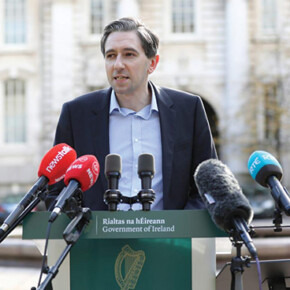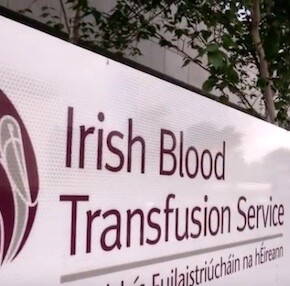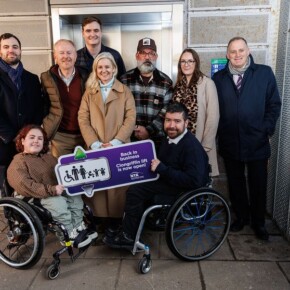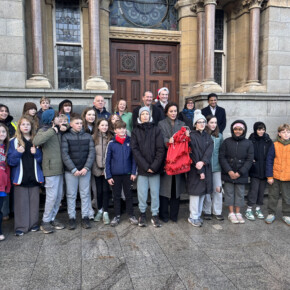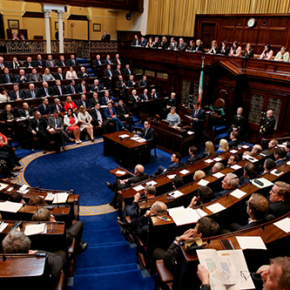Fear And Loathing On The Campaign Trail 25: Clarity in short supply
Mike Finnerty 13 Aug 2025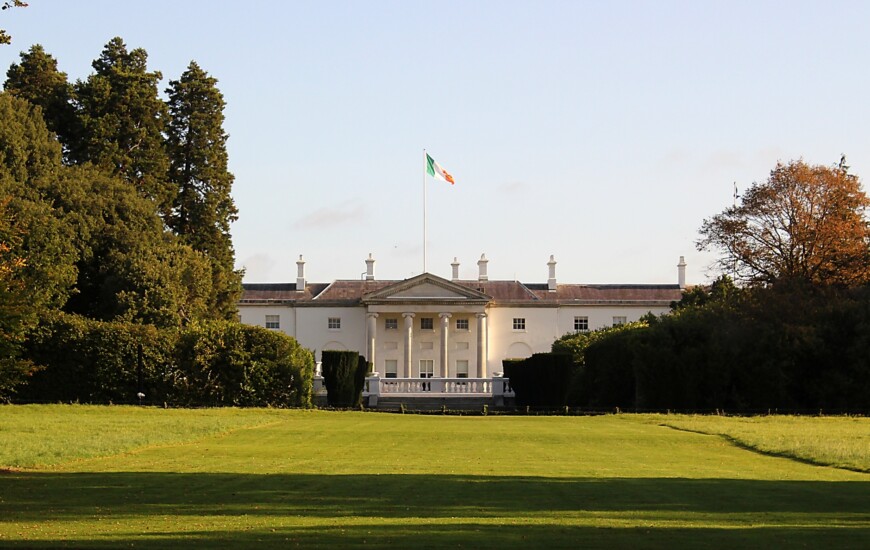
Editor’s note: This article was written and appeared in print prior to Mairead McGuinness’ withdrawal from the race on August 14th.
While there is no set date for the presidential election, time is running out for Fianna Fáil and Sinn Féin to figure out their strategy.
Two of the oldest parties in the state are weeks out from a presidential election with no clear indication of what the game plan is.
The oldest party in the country, Labour, has its house in order.
Late last week, it was announced that the party would be backing former member Catherine Connolly as part of a broad left-wing presidential bid.
Two political parties with big birthdays this year, People Before Profit (turning 20) and the Social Democrats (turning 10), were the first to back Connolly and her campaign, meaning that Connolly now has the support of three left-of-centre parties.
Fine Gael, the second leg on the government stool, also have their ducks in a row, selecting Mairead McGuinness as its candidate, with party sources stating that McGuinness’ tilt at the Áras was decided as early as the summer of 2024.
So – what is the game plan for the main government party and the main party in opposition?
Fianna Fáil and Fine Gael both separately announced they will be running candidates earlier this year, just months after agreeing to repeat their grand coalition that was formally sealed in 2020 and continued following the results of 2024’s general election.
Considering tensions within the parties in recent weeks, most notably the row over student fees or the blame game over housing, it might have been for the best for the couple that they spend some time apart during a presidential campaign that will no doubt turn ugly.
Fianna Fáil are split about how to approach the presidency; the party old guard, such as veteran TD Willie O’Dea, have argued that Fianna Fáil should not run a candidate for the sake of running a candidate, while the newer cohort from the post-2011 class believe that the party should run a candidate in the centre of Connolly’s unabashed leftism and McGuinness’ agricultural bent.
There is a feeling within Fianna Fáil that the party should take advantage of Connolly being from Galway and McGuinness being from Meath, and run a candidate from Dublin.
Former Minister Mary Hanafin has made it known she wants to the Fianna Fáil’s candidate, while former Taoiseach Bertie Ahern will tell any microphone that listens that he is interested in the role.
Media reports have indicated that MEP Barry Andrews was approached by the party but said no; considering Andrews topped the poll in the race for Europe last year, his proven ability to win a major vote like Dublin’s European constituency would have been a boon to the party.
There is trepidation within Fianna Fáil ranks about Hanafin running; Hanafin notably served as Minister for Social Protection at the height of the economic crash in 2008 and 2009, and history has shown that Fianna Fáil utterly flatlines when faced with a scandal or crisis in a presidential election.
Hanafin’s time as Minister remains controversial; she was trotted out by the party to defend the latest cut to welfare and government services.
Invoking memories of the 2008 economic crash, likely at a time of economic hardship for Ireland, means there are major reservations about Fianna Fáil running Hanafin or, indeed, Ahern.
Sinn Féin, meanwhile, are approaching the presidential election with the will-they-won’t-they tension of Sam and Diane on Cheers.
It was reported earlier this year that Sinn Féin had taken part in preliminary talks with Labour, the Social Democrats, the Greens and People Before Profit about the prospect of a joint left-wing bid for the Áras.
When asked by reporters about Sinn Féin taking part in a broad left ticket, party leader Mary Lou McDonald said “it would make sense” for her party to be involved, but said that the party had to carry out its own internal review before making a decision.
Sinn Féin’s stance is understood to be split between three camps: back Connolly (despite rumblings from party higher-up she is not “sufficiently republican enough”), run their own candidate, or sit the campaign out entirely.
In terms of option one, Sinn Féin doubting Connolly’s republican credentials stems from the fact that yes, Connolly is of the left, but isn’t of “their” left.
Conor Murphy being brought down from Stormont, swapping his Minister for Finance brief for a seat in the Seánad, is a clear indication that Sinn Féin wants to push the conversation on a United Ireland forward, and some elements within Sinn Féin doubt Connolly’s commitment to republican ideals.
The party choosing to field a candidate against Michael D Higgins in 2018 also points to the party broadly supporting the Irish left, but not enough to row in behind one candidate.
In 2018, Sinn Féin’s decision to field a candidate, then-MEP Liadh Ní Riada, massively backfired with Ní Riada receiving just 6.4% of the vote, or to put it in more historical terms, less than half of what Dana received in the 1997 election.
As recently as this week, McDonald hinted that option two, running their own candidate, could be on the table, telling reporters that elections are decided on transfers and insisting that a solo Sinn Féin run would not split the left-wing vote.
The new Dáil has seen the parties of the left combine for the “combined opposition” and share common ground on the likes of disability rights, Gaza, the cost of living crisis and housing, but deeper down, have some fairly major differences on ideology.
Recent weeks revealed tension between the Social Democrats and Sinn Féin’s arrangement to co-operate on Dublin City Council and Dublin’s local authorities; both parties were notably split on the issue of the Local Property Tax.
Elsewhere on the left, Labour has strongly criticised Sinn Féin’s stance on LGBTQ+ rights in light of the Cass Ruling in the UK as well as their stance on Ukranian refugees, while People Before Profit still harbours resentment towards Sinn Féin for visiting the White House in March 2024 despite demands from People Before Profit not to visit the United States over it’s pro-Israel stance.
The idea of a left-wing presidential campaign was floated as early as January by Labour leader Ivana Bacik, and Labour agreeing to back Connolly is notable, as well as intelligent from an optics standpoint.
Labour has spent most of its time since being unceremoniously turfed out of office in 2016 trying to convince fellow parties of the left that they are still the party of Connolly – in 2025, they are less the party of James, but are willing to back a campaign by Catherine.
Dublin South-West TD Ciáran Ahern will be chairing the Labour part of the Connolly campaign, and Labour’s involvement in a presidential bid is usually a good omen.
In three of the last five presidential elections, a Labour-backed candidate has gone on to win the race (1990, 2011 and 2018).
Ahern himself said, “while there are issues where we have differed with Deputy Connolly, we are determined that the social democratic values of equality, justice and tolerance should shape the Presidency over the next seven years and follow the legacy of Michael D Higgins. “
“We believe that Catherine Connolly shares those values and has put them into practice during her political career.”
Labour backing Connolly is significant as the two camps haven’t always seen eye-to-eye.
In her days on Galway City Council, Connolly notably resigned from Labour in 2006 after lobbying the party’s higher-ups about being Michael D Higgins’ running mate in the 2007 general election, and resigned from the party after that request was not granted.
After winning the election to the Dáil in 2016, Connolly notably served as Leas-Cheann Comhairle in the last Dáil, becoming the first woman to hold the role.
Connolly is a bit farther to the left than what the modern-day Labour party would perhaps like, but after consulting party members, the feedback was unanimous; back Connolly.
The move to back the Galwegian could be an astute one.
In backing Connolly, Labour has now thrown down the gauntlet to Sinn Féin and has asked them, “how serious are you about a united left-wing front?”
The participation of Labour, the Social Democrats and People Before Profit means that Sinn Féin are now in an awkward spot; either they put their money where their mouth is and join up with the parties they need to form a left-wing coalition after the next general election, or attempt another solo run.
Labour notably refused to back Mary Lou McDonald for Taoiseach when it came to a Dáil vote last December, but that was before the parties of the left made a conscious decision to band together and hold the government to account as part of the Combined Opposition.
The election must take place before November 11; recent history indicates the government will set the final Friday of October as the election date, as was the case in 1997, 2011 and 2018.
In that case, this year’s presidential campaign will be much like last year’s general election; a fast and furious one, where the smallest mistakes are put under the microscope.
Candidates are advised to steer clear of Kanturk, cheques from businessmen or journalists with tape recorders..


